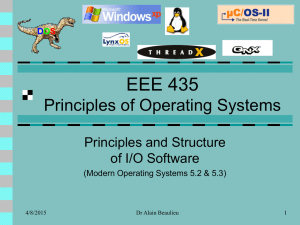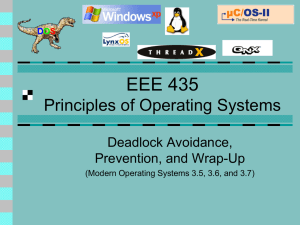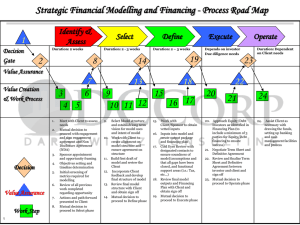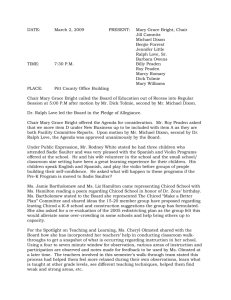EEE 435 Principles of Operating Systems
advertisement
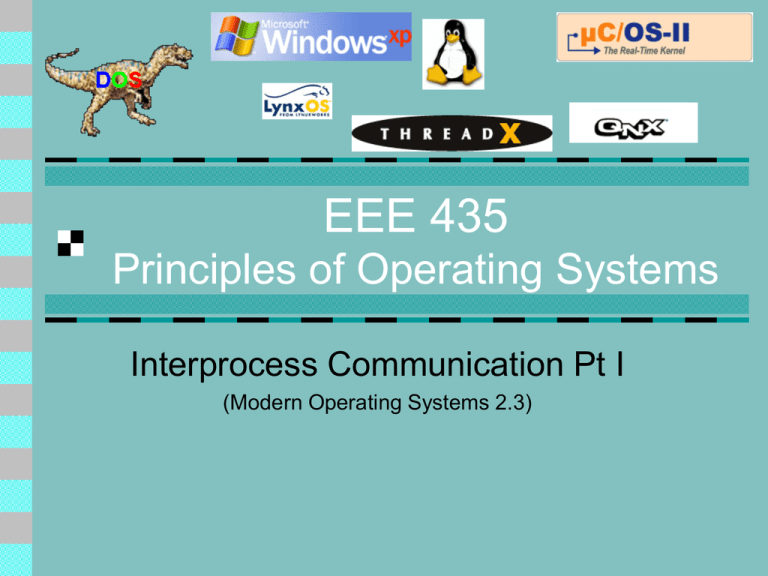
EEE 435 Principles of Operating Systems Interprocess Communication Pt I (Modern Operating Systems 2.3) Quick Review What are our three main choices in deciding where to implement threads? Name some of the advantages in having threads in user space over the kernel. 4/13/2015 Dr Alain Beaulieu 2 Outline Interprocess Communication (IPC) Overview Race Conditions Critical Regions Mutual Exclusion Mutual Exclusion Methods 4/13/2015 Dr Alain Beaulieu 3 IPC Overview To achieve useful work, many times processes may need to communicate with one another How do processes send information to each other? How do we prevent processes from interfering with one another’s activities? How do we have one process wait on another’s activities? (ie: Process A produces data for use by Process B) 4/13/2015 Dr Alain Beaulieu 4 Race Conditions Applies to systems where process are working together but share some area of common storage for read/write main memory shared file device register 4/13/2015 Dr Alain Beaulieu 5 Race Conditions Example: a print spooler When a process wants to print, it places the file name in a spooler directory in an appropriate slot •Each slot holds a file name •Two shared variables: •out points to next file to be printed •in points to the next free slot •A printer daemon periodically checks to see if there are any files to be printed •Is there a problem with this? 4/13/2015 Dr Alain Beaulieu 6 Race Conditions Print Spooler Example Process A Process B freeSlot = in; writeName(freeSlot); in = freeSlot+1; doMoreStuff(); freeSlot = in; writeName(freeSlot); in = freeSlot+1; doMoreStuff(); A switch to another process at an inopportune moment causes Process B to lose its print job... 4/13/2015 Dr Alain Beaulieu 7 Race Conditions A Race Condition is a situation where two or more processes are accessing shared data and the final result depends on the order in which the processes execute Therefore, the place in code where it is possible that race conditions could be created is of particular interest to us and is referred to as a Critical Region (or critical section) 4/13/2015 Dr Alain Beaulieu 8 Critical Regions Ideally, we avoid having areas of code where race conditions can occur, but this is not always possible Programs must be arranged/designed in such a way such that no two processes may be operating in their (related) critical regions at the same time The critical regions must be Mutually Exclusive 4/13/2015 Dr Alain Beaulieu 9 Mutual Exclusion It is now obvious that critical regions must operate in mutual exclusion, but that is not a sufficient definition for our needs. The solution to prevent race conditions must meet these requirements: 1) No two processes may be simultaneously inside their critical regions 2) No assumptions may be made about speed or number of CPUs 3) No process running outside its critical regions may block other processes 4) No process should have to wait forever to enter its critical region 4/13/2015 Dr Alain Beaulieu 10 Mutual Exclusion A pictorial representation of our requirements for mutual exclusion 4/13/2015 Dr Alain Beaulieu 11 Mutual Exclusion Methods Three potential solutions: Disable interrupts Use lock variables Strict alternation 4/13/2015 Dr Alain Beaulieu 12 Mutual Exclusion Methods Disabling interrupts: Each process disables interrupts as they enter their critical region. With interrupts disabled, no context switching to other processes will occur Problem: If the user thread locks/goes into an endless loop the OS locks/crashes Problem: What happens with multiple CPUs? Problem: If the critical region is large, what if a device needs attention Viable solution? No. 4/13/2015 Dr Alain Beaulieu 13 Mutual Exclusion Methods Lock variables: Share a lock variable (called, say, lock) When a process wants to enter its critical region it examines lock, and if it’s 0, sets it to 1 and enters its critical section Problem: this has simply moved the race condition elsewhere. A switch to another process at an inopportune moment results with both processes in their critical regions simultaneously Viable solution? No. 4/13/2015 Dr Alain Beaulieu 14 Mutual Exclusion Methods Strict Alternation Process A Process B Note the semicolon after the while() statements – creates a mini-loop Continuously testing a variable until some value appears is called Busy Waiting 4/13/2015 Dr Alain Beaulieu 15 Mutual Exclusion Methods Strict Alternation works as named: processes take turns entering their critical regions The mini while loop is used as a lock to prevent entry into the critical region. A lock that uses busy waiting is called a spin lock Problem: condition 3 violated – if A executes faster than B then A waits to enter its critical region while B executes non-critical code Viable solution? No. But it’s close... 4/13/2015 Dr Alain Beaulieu 16 Mutual Exclusion Methods Peterson’s Solution 4/13/2015 Dr Alain Beaulieu 17 Mutual Exclusion Methods Peterson’s Solution Critical region now protected Viable solution? Yes! 4/13/2015 However, busy waiting is still required...a waste of precious, precious CPU time Note also that processes must not cheat: if they don’t call enter_region and leave_region, the scheme breaks down Also works only for two processes. If more use the baker’s algorithm Dr Alain Beaulieu 18 Mutual Exclusion Methods Some help from the hardware: TSL TSL is the Test and Set Lock instruction Many computers support an instruction like this How is it used? TSL RX,LOCK Read the contents of the memory word LOCK into register RX and store a nonzero value at memory address LOCK The actions of reading the word and storing the nonzero value and setting LOCK are indivisible, guaranteed! 4/13/2015 Dr Alain Beaulieu 19 Mutual Exclusion Methods How do we use the TSL instruction? Like Peterson’s solution, we surround the critical region with calls to enter_region and leave_region Viable solution? Yes! (With busy waiting...) 4/13/2015 Dr Alain Beaulieu 20 Quiz Time! Questions? 4/13/2015 Dr Alain Beaulieu 21

